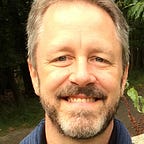Ecologies of Sacred Hospitality — Massively-Leveraged, Scalable Impact
Chopra, D. (2019). Metahuman: Unleashing Your Infinite Potential. New York, Harmony Books.
Clouse, C. (2016). Making It Home: Finding Your Power and Purpose. Bloomington, AuthorHouse.
Downes, K. (2000). Sacred Spaces: Restoring Harmony. Melbourne, Lifetime Publications.
McTaggart, L. (2008). The Field: The Quest for the Secret Force of the Universe. New York, Harper.
Are very high-performing individuals and groups supernatural or normal? Are they doing what very few of us can do or not doing what most of us do? The authors of the books listed above describe a way of understanding our common experience about what our reality looks like. What’s new isn’t their description of our experience, rather what they describe of what we can see once we acknowledge this experience. They begin to integrate into one experience many different aspects of our experience.
An Ecology of Nature. What is nature, how are we part of it, and how do we relate to it? In The Divine Matrix, Gregg Braden brings in physics to show that our daily experience might be a “Projection of things happening in another realm that we cannot observe..from a higher vantage point” (p.xii). He reminds us of Nobel laureate Max Planck’s 1944 observation, “There is no matter as such! All matter originates and exists only by virtue of a force which brings the particles of an atom to vibration and holds this minute solar system of the atom together” (p56). In The Field, Lynne McTaggart brings together a wide variety of rigorous disciplines robustly describing the energetic field that manifests reality, whether we experience this as matter or as energy. Bringing in research by the biophysicist Popp, “all living things — from the most basic of plants or animals, to human beings in all their sophisticated complexity — emitted a permanent current of photons, from only a few to hundreds” (p49). Literally beings of light. The universe of mass is a universe of of energy, of light, of an energy field. In Sacred Spaces, Karen Downes gives daily practices that help us remember this relationship we have with and as nature. We can set up the conditions to support our continuous remembering of this.
An Ecology of Consciousness. What is a human, what is our potential, and how do we participate in our humanness? In Metahuman, Deepak Chopra interweaves cosmology and medicine to explore the greater potential of what humans are. “There are ways in which outer reality is much more malleable through consciousness than anyone supposes. Since consciousness is the foundation of reality, we shouldn’t set down any absolute limits… in the inner domain of consciousness, the possibilities for new thoughts, insights, and discoveries is already unlimited…infinite possibilities are part of our makeup. But something inside us resists believing in infinity as a human quality. Edited reality feels more comfortable” (p77). “To take advantage of infinite potential, you must accept that reality is open-ended, capable of taking subtle, invisible impulses and turning them into mind and matter” (p79). In Becoming Supernatural, Joe Dispenza shows us that everybody is nature and above nature, natural and supernatural. Everyone, by definition. We are energy, “all energy is frequency and all frequency carries information…The only way we can change our lives is to change our energy–to change the electromagnetic field we are constantly broadcasting” (p 34). When looking at the full spectrum of electromagnetic frequencies, “The majority of frequencies are beyond our perception, and therefore most of our non-reality in this universe cannot be experienced by our senses. So aside from our ability to perceive light being absorbed or reflected off objects and things, the truth is that we are able to perceive only a very small spectrum of reality. There’s a lot of other information available to us besides what we can see with our physical eyes” (p86). In Making It Home, Chris Clouse brings practices to strengthen our ability to work with our different nerve-ganglia-brains throughout the human body as a geometry of energy wave patterns that we call awareness.
An Ecology of Consciousness and Nature. Putting these two together, what are we, as simultaneously nature and consciousness? Our research explores what an ecology of nature might look like, what you see as your basic nature, and how that combines with an ecology of consciousness. Basically, we are energy. All of it. And, the energy field that is each one of us exists within a field of energy. Understanding this gives us access to great amounts of power. Not understanding this blocks much of the energy already available for us, both as individuals and as groups. Accessing it is a matter of understanding it and working with it, a gift these authors give us.
